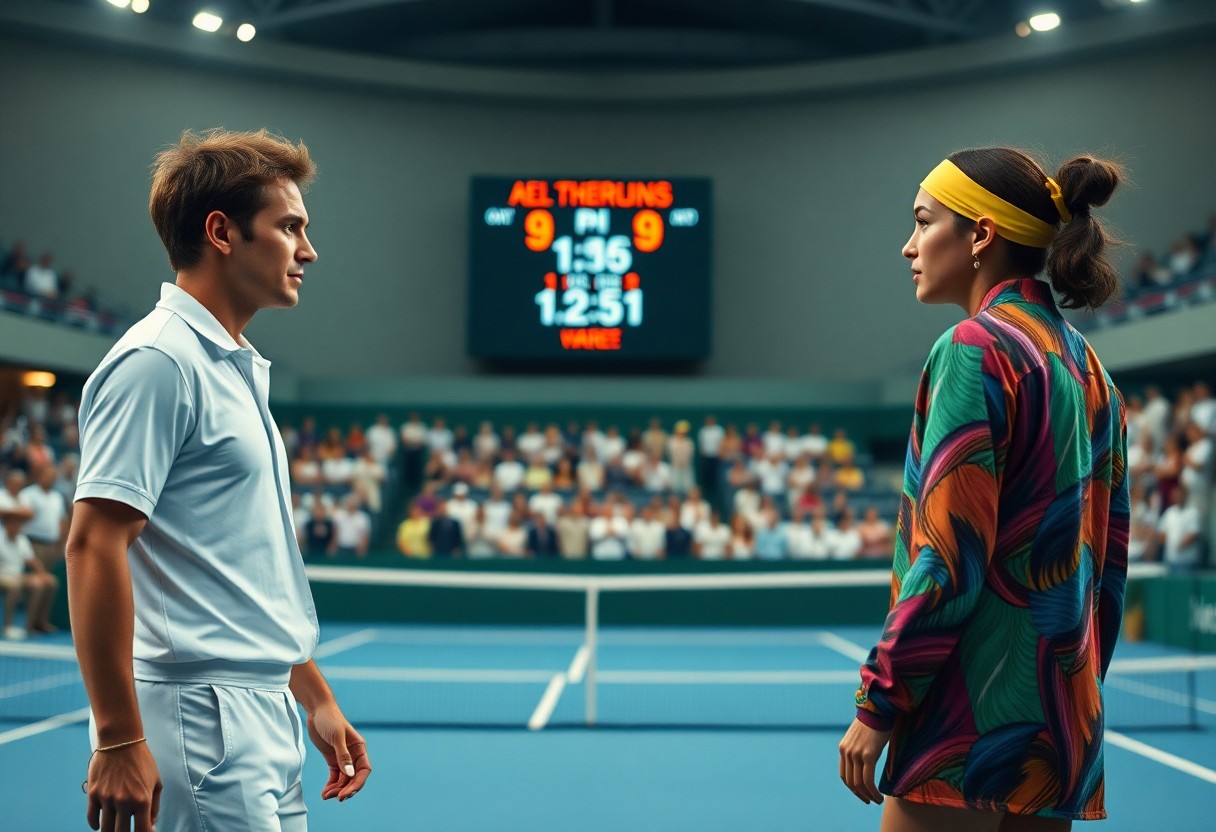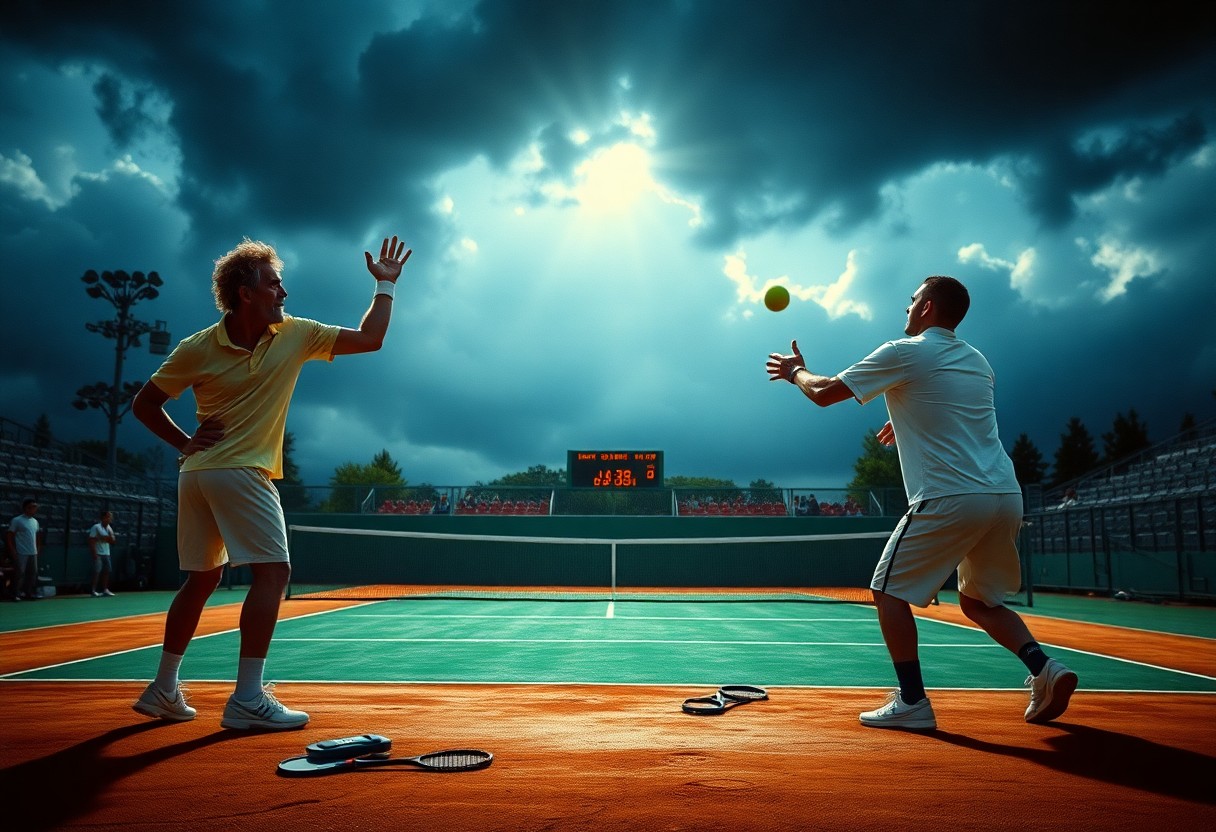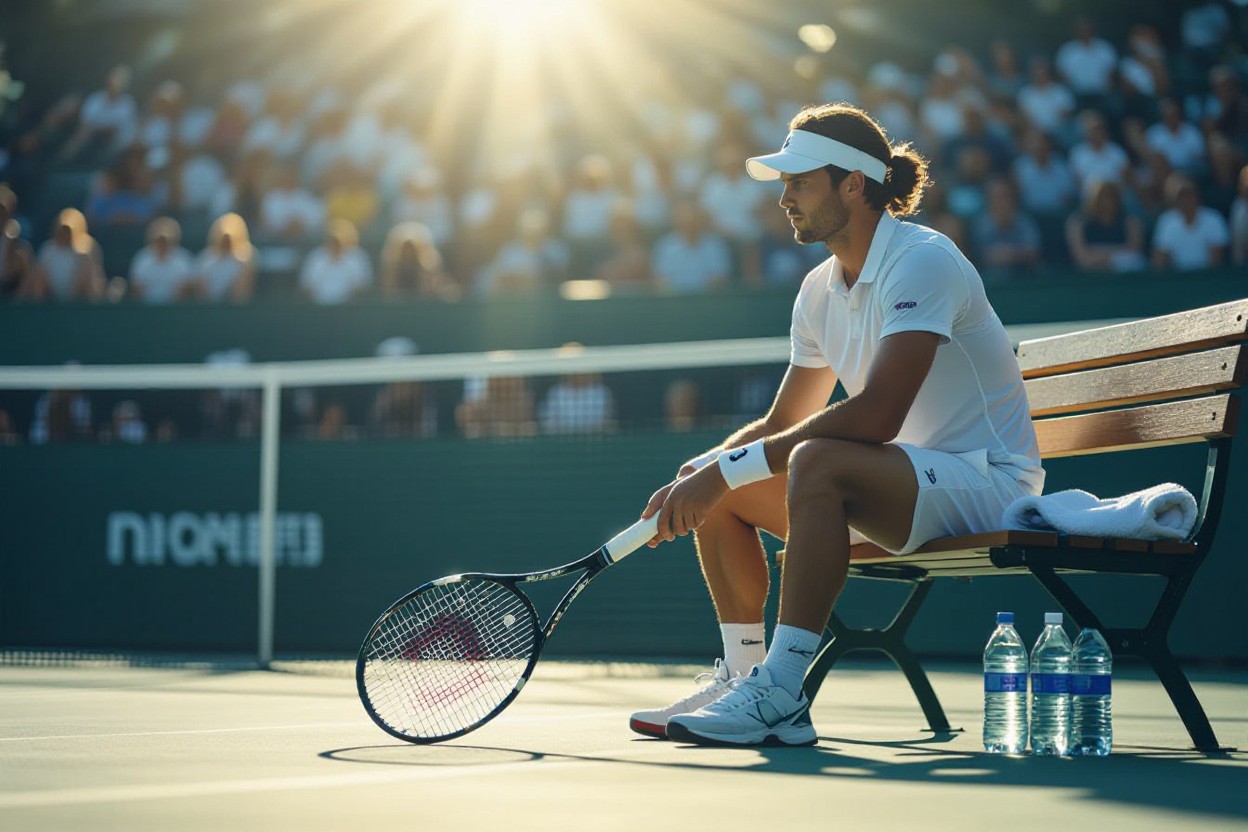Tennis rivalries captivate you not merely through their statistical outcomes, but through the complex psychological warfare that unfolds between competitors. When you witness legendary matchups like Federer-Nadal or Djokovic-Murray, you’re observing more than athletic prowess—you’re seeing mental chess matches where confidence, intimidation, and psychological pressure determine victory. These rivalries create dangerous momentum shifts that can instantly transform a player’s career trajectory, while simultaneously pushing both athletes to transcend their individual limitations. Understanding the psychological dynamics behind these confrontations reveals why certain players consistently elevate their performance against specific opponents, regardless of rankings or recent form.
The Emotional Battlefield: Parsing Passion and Rivalry Dynamics
Tennis rivalries transform the court into an emotional pressure cooker where psychological warfare becomes as vital as physical prowess. You witness players channeling years of accumulated tension, disappointment, and competitive fire into each point, creating an atmosphere that transcends typical match dynamics. The intensity reaches levels where heart rates spike beyond 180 BPM during crucial moments, and cortisol levels can increase by 300% compared to regular matches. Your understanding of these rivalries deepens when you recognize that each encounter carries the weight of previous battles, creating a compound emotional effect that amplifies performance under pressure.
The Role of Emotion in Tennis Rivalries
Emotional investment in rivalries creates a double-edged psychological sword that can either elevate or devastate performance. You see players like Djokovic feeding off crowd hostility to fuel his comeback victories, while others crumble under the weight of expectation. Research shows that moderate emotional arousal improves reaction time by 12-15%, but excessive emotion can decrease accuracy by up to 25%. Your favorite rivalries often feature players who’ve mastered this emotional tightrope, using passion as fuel rather than allowing it to become destructive interference.
Psychological Tactics Employed on Court
Strategic psychological manipulation becomes an art form during heated rivalries, with players employing calculated disruption techniques to unsettle opponents. You observe time violations, extended towel breaks, and deliberate pace changes designed to break momentum and concentration. McEnroe’s legendary outbursts weren’t just emotional releases—they were tactical weapons that shifted crowd energy and opponent focus.
Modern players have refined these psychological tactics into more subtle forms of mental warfare. You notice how Djokovic bounces the ball exactly 15-20 times before serving in high-pressure moments, creating a rhythm that simultaneously calms his nerves while potentially frustrating impatient opponents. Nadal’s pre-point rituals extend match duration by an average of 23 minutes, wearing down opponents both mentally and physically. These aren’t nervous habits—they’re calculated strategies. Your analysis reveals how players study opponents’ emotional triggers: Federer’s occasional racket smash was so rare it carried devastating psychological impact, while Serena Williams’ intensity celebrations were designed to demoralize opponents before the next point even began. The most successful rivalry participants understand that winning the psychological battle often determines the physical outcome.
History’s Echo: How Past Encounters Shape Present Showdowns
Every time you watch two familiar opponents step onto the court, you’re witnessing the accumulation of years of psychological warfare. Past matches create invisible threads that connect present moments to previous victories and defeats. Djokovic’s dominance over Murray in Grand Slam finals (8-3 record) doesn’t just represent statistical superiority—it represents a mental blueprint that both players carry into each new encounter. Your understanding of these historical patterns reveals how tennis rivalries transcend individual matches, becoming ongoing psychological narratives where each point played carries the weight of every previous exchange.
Lessons from Iconic Matches
Specific matches become psychological reference points that define entire rivalries. Nadal’s 2008 Wimbledon victory over Federer didn’t just end a five-set epic—it fundamentally shifted their mental dynamic. Before that match, Federer held a 6-1 head-to-head advantage on grass and hard courts. After witnessing Nadal conquer him on his most dominant surface, you can trace how Federer’s confidence against his Spanish rival never fully recovered. These landmark encounters create lasting psychological imprints that influence tactical decisions, shot selection, and mental approach in subsequent meetings years later.
The Weight of Legacy and its Psychological Impact
Legacy pressure intensifies when you consider how historic rivalries shape career narratives. Each encounter becomes a referendum on greatness rather than simply another match. Djokovic’s pursuit of the Grand Slam record added layers of psychological complexity to his matches against Nadal and Federer, transforming routine encounters into legacy-defining moments. Your appreciation for these dynamics explains why late-career matches often carry disproportionate emotional weight—players aren’t just competing for titles, but for their place in tennis history.
The psychological burden of legacy manifests differently across various stages of a rivalry’s evolution. Early encounters establish dominance patterns, but later meetings become exercises in legacy management where your mental approach shifts from proving superiority to preserving historical standing. Federer’s final matches against Djokovic carried the weight of potentially cementing or undermining his GOAT credentials. This pressure creates unique psychological scenarios where your tactical decisions become influenced not just by winning the immediate match, but by how that victory or defeat will be interpreted within the broader context of career achievements. Players often describe feeling the presence of tennis history during these encounters, where each point played contributes to narratives that will outlast their careers.
The Mind Game: Mental Health and Pressure in High-Stakes Rivalries
Your favorite tennis rivalries unfold not just on the court but within the complex psychological landscape of each player’s mind. Elite athletes face cortisol levels that spike 300-500% during major matches, while their heart rates can reach 180-200 BPM even during changeovers. Players like Novak Djokovic have openly discussed panic attacks during early career matches, while Naomi Osaka’s withdrawal from Roland Garros highlighted how media pressure in rivalries can trigger severe anxiety and depression. You’re witnessing gladiatorial combat where mental fortitude often determines victory more than physical prowess.
Stress, Anxiety, and Performance
Your body’s fight-or-flight response activates identically whether you’re facing a charging lion or Rafael Nadal’s forehand down the line. Studies show that tennis players experience anxiety levels comparable to those of emergency room doctors during Grand Slam finals. Serena Williams famously vomited before major matches due to pre-game nerves, yet channeled that energy into 23 Grand Slam victories. Performance anxiety can reduce reaction time by up to 15% and decrease accuracy by 20%, explaining why some players crumble under pressure while others, like Roger Federer, seem to transcend it entirely.
Psychological Resilience Strategies for Players
Your mental toolkit determines survival in tennis warfare. Top players employ visualization techniques, spending 30-45 minutes daily mentally rehearsing match scenarios. Andy Murray worked with psychologist Alexis Castorri to develop breathing patterns that lowered his heart rate by 10-15 BPM during pressure points. Mindfulness meditation, used by 78% of top-100 players, helps maintain focus during three-hour battles where a single lapse can cost championships.
Your understanding of these resilience strategies reveals their sophisticated nature. Players like Djokovic practice “emotional reset” techniques between points, using specific trigger words or gestures to return to baseline psychological states. Sports psychologists now work with players on “pressure training,” deliberately creating high-stress practice scenarios that simulate rivalry atmospheres. Rafael Nadal’s famous pre-serve routine isn’t superstition—it’s a carefully crafted psychological anchor that maintains consistency regardless of external pressure. Modern players also utilize biofeedback technology, monitoring real-time stress indicators through wearable devices that track heart rate variability, allowing them to implement calming techniques before anxiety peaks. The most successful rivalry performers have learned to reframe pressure as privilege, viewing high-stakes moments not as threats but as opportunities to demonstrate their mental superiority over opponents who buckle under identical circumstances.
Spectator Psychology: Why Fans Buy into Rivalries
Your brain becomes a willing participant in tennis rivalries long before you consciously choose sides. Neurological studies show that watching competitive sports activates the same reward pathways as direct participation, creating an addictive cycle of emotional investment. You’re not simply observing a match—you’re experiencing vicarious competition through mirror neurons that fire as if you were holding the racket yourself. This psychological phenomenon explains why you find yourself checking scores obsessively during a Djokovic-Nadal clash or why your heart rate spikes during crucial break points, even from your living room couch.
The Dopamine Hit of Competitive Drama
Every unexpected winner and dramatic comeback triggers a dopamine release in your brain’s reward center, creating the same neurochemical response as gambling or eating chocolate. Tennis rivalries amplify this effect through unpredictability—you never know when Federer might produce magic against Djokovic or when an underdog will upset the established order. Research indicates that intermittent reinforcement schedules, like those found in closely contested matches, produce stronger addiction patterns than consistent rewards, explaining why you keep returning to watch players you’ve seen compete dozens of times before.
The Influence of Social Identity on Fan Loyalty
Your allegiance to specific players becomes intertwined with your personal identity, creating what psychologists call “basking in reflected glory.” Studies show that fans use pronouns like “we” when their preferred player wins and “they” when they lose, demonstrating how deeply you internalize athletic success and failure. Supporting Serena Williams or Rafael Nadal isn’t just about tennis—it’s about aligning yourself with values, playing styles, and narratives that reflect your self-concept.
This psychological attachment runs deeper than surface-level preferences, often connecting to your cultural background, personal struggles, or aspirational goals. Research from the University of Kansas found that sports fans show measurable increases in testosterone levels when their team wins, proving that your body literally responds to your chosen player’s success as if it were your own achievement. You might gravitate toward Nadal’s relentless work ethic if you value perseverance, or connect with Federer’s effortless elegance if you appreciate artistic expression. These connections become so embedded that switching loyalties feels like betraying part of yourself, which explains why you’ll defend your favorite player’s controversial calls or rationalize their poor performances rather than acknowledge their flaws.
Game Theory: Strategy and Psychological Warfare
Tennis operates as a complex chess match where every shot carries dual purpose – physical execution and psychological manipulation. Players constantly calculate risk-reward scenarios while simultaneously attempting to disrupt their opponent’s decision-making process. Novak Djokovic’s famous ball-bouncing routine exemplifies this dual strategy, serving both as personal preparation and a method to unsettle opponents’ timing. You witness game theory principles in action when players deliberately show weakness in one area to bait opponents into predictable patterns, then exploit those tendencies. The mental scoreboard often diverges significantly from the actual score, with perceived momentum shifts influencing strategic choices more than statistical probabilities.
Anticipating Opponent Moves and Countermoves
Elite players develop pattern recognition systems that operate at subconscious levels, reading subtle body language cues and court positioning to predict incoming shots. Rafael Nadal’s exceptional return positioning demonstrates this skill – he adjusts his stance milliseconds before his opponent’s racquet makes contact, gaining crucial reaction time. Statistical analysis reveals that top players correctly anticipate shot direction 73% of the time compared to 45% for recreational players. Your ability to layer deception into shot preparation becomes equally important, as opponents simultaneously attempt to decode your intentions while masking their own strategic adjustments.
The Impact of Mind Games on Match Outcomes
Psychological warfare can shift match momentum more dramatically than superior shot-making ability. Players employ tactics ranging from subtle gamesmanship to overt intimidation, with studies showing that effective mind games can reduce opponent’s first-serve percentage by up to 12%. Nick Kyrgios’s unpredictable on-court behavior exemplifies how psychological disruption can neutralize technically superior opponents, forcing them out of established rhythms and comfort zones.
The cumulative effect of sustained psychological pressure often manifests during pivotal moments, where mental fatigue compounds physical exhaustion. Research from the International Tennis Performance Association indicates that matches involving significant psychological warfare average 23% longer than baseline encounters, with the mentally stronger player winning 68% of deciding sets. Your opponent’s increased decision-making time between points, altered serving patterns, and deviation from preferred shot selection all signal successful psychological influence. John McEnroe’s calculated outbursts weren’t merely emotional releases but strategic tools designed to break opponents’ concentration while energizing his own performance, demonstrating how controlled aggression can become a tactical weapon when deployed systematically.
Summing up
Following this exploration of tennis rivalries, you can see that the psychological dimensions extend far beyond match statistics and head-to-head records. Your understanding of these competitive relationships reveals how mental warfare, emotional intelligence, and strategic adaptation shape the sport’s greatest battles. When you observe legendary rivalries, you witness complex psychological chess matches where players exploit weaknesses, manage pressure, and evolve their mental approaches. These rivalries demonstrate that tennis success depends not only on physical prowess but on your ability to navigate the intricate psychological landscape that defines elite competition.




